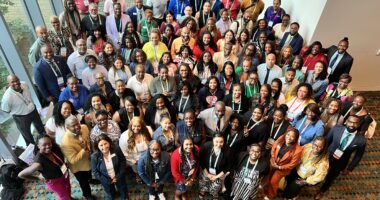Leading Schools With an Equity Lens
Lessons learned from the NAESP Pre-K-8 Principals Conference will help you start the new school year with a focus on leading schools with an equity lens.

“This is our moment,” said U.S. Secretary of Education Miguel Cardona during a recorded message at the start of the recent NAESP Pre-K-8 Principals Conference in Chicago. The new secretary of Education thanked education leaders, reminded us to take care of ourselves, and then challenged all education leaders to be change agents in our school districts, to create a public school system that is “stronger and more equitable than it was in the past.”
The past year and half has been a difficult time for school leaders across the country. COVID-19 safety protocols, social distancing, remote and hybrid learning, masks, quarantining, and contact tracing meant principals had to learn a completely new skill set. Before the pandemic, school districts struggled with inequities; post-pandemic the opportunity gaps have widened tremendously and educational equity is on everyone’s minds.
Rethinking Equity
Now is the time to make changes, think differently, and work to create equitable learning environments instead of reverting to “normal.” We just made it through a very dangerous time, and sadly, not everyone survived. It will be extremely dangerous if we as leaders “go back to normal” as we reopen our schools and start the 2021-2022 school year.
People think they want to go back to how things were, but how things were means going back to a system where so many of our students were underserved and under-represented. And going back to how things were with students who survived a pandemic while dealing with a laundry list of inequities that surfaced or resurfaced as a result of this past year would not be doing what is best for kids.
When thinking about creating a more equitable system in our schools and districts, we should think about the words of education professor Pedro Noguera: “That’s at the core of equity: understanding who your kids are and how to meet their needs. You are still focused on outcomes, but the path to get there may not be the same for each one.” This theme resonated throughout many sessions and keynote speakers; connecting with kids and figuring out what their individual needs are should be our top priority this year.
Setting the Tone and Focus
Principal Baruti Kafele was exactly the voice we needed as our kickoff keynote speaker at the NAESP conference. As he told us the story of his own experience with school, he emphasized the importance of not only knowing who your kids are but also believing in them and their possibilities, regardless of the privileges they do or don’t have. What a huge responsibility we have as the leaders of our schools. Kafele said, “Just one principal can alter the trajectory of an entire school.” And it’s true. As school leaders, we set the tone and the focus.
Kafele stressed the importance of equity mindset teaching. But what exactly is it? An “equity mindset teacher” is a teacher who uses a variety of developmentally appropriate instructional strategies that consider the differing academic, social, and emotional needs of each of the learners in a student-centered, culturally relevant, barrier-free equity mindset classroom, where student individuality, cultural identity, and voice matter exponentially.
As we approach this year with an equity lens, Kafele’s words should be echoing in our ears: “We are not talking about the all; we are talking about the each.”
Shifting From Discipline to Support
Many presenters at the NAESP conference shared and discussed educational equity and leading with an equity lens.
- Andy Jacks, principal and senior fellow for the NAESP Centers for Advancing Leadership, encouraged leaders to shift from a “discipline plan” to a “support plan” during his session titled “Discipline Win.”
- Principal-turned-superintendent Shanna Spickard shared strategies on how to lead difficult conversations around race with staff and students.
- Members of the NAESP National Task Force on Race and Equity spoke to a packed room about how school leaders can become equity leaders, sharing resources to help improve the racial inequities in our schools.
- Howard Fields III, author of How to Achieve Educational Equity, reminded us to “not forget the importance of including students in your plans.” He also dropped a powerful truth bomb that school and district leaders need to be aware of: “The problem is that we want equity to coexist with inequity in our schools to keep everyone happy. We are open to increasing staff diversity but closed to increasing diversity within the curriculum. We want to provide added supports for students in need, while simultaneously giving more to students who are not in need, perpetuating the same system we are trying to disrupt.” That statement might be a tough reality pill to swallow, but it is one that we need to dig deeper into if we are going to create a more equitable system.
Educational equity is not a new issue, but it is one that we must face head on as we reopen our schools and plan for this school year—the school year that’s coming after the over-used but accurate “unprecedented school year.” When we look back on this upcoming school year, how will it be described? Will it be unconventional? Will it be unlike previous school years? Will it be “stronger and more equitable than it was,” as Cardona stated?
As Heidi Hayes Jacobs, author and educational leader, has shared when talking about post-pandemic planning, we must “use COVID as an opportunity to reset and reimagine, not just to recover.” As school leaders, we have a choice to make: settle for returning to “normal,” an educational system that struggled with inequities or seize this opportunity to forge a new path, a stronger path, a more equitable path, for each of our students, schools and communities. The choice is yours.
Liz Garden is principal of Dr. Leroy E Mayo Elementary School in Holden, Massachusetts.




